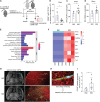Gut microbiota deficiency reduces neutrophil activation and is protective after ischemic stroke
- PMID: 40410847
- PMCID: PMC12100894
- DOI: 10.1186/s12974-025-03448-w
Gut microbiota deficiency reduces neutrophil activation and is protective after ischemic stroke
Abstract
Neutrophils are readily activated immune cells after ischemic stroke in mice and patients. Still, the impact of gut microbiota on neutrophil activation and its influence on inflammatory brain injury remain undefined. We report that natural microbiota colonization of germ-free (GF) mice induces substantial neutrophil activation and deteriorates stroke pathology. The colonized Ex-GF stroke mice had considerably larger infarct sizes and higher sensorimotor deficits than GF littermates. Furthermore, employing an antibiotic-based mouse model of microbiota deficiency, we demonstrate that gut microbiota depletion induces a juvenile neutrophil phenotype characterized by the upregulation of resting state surface receptors, reduced inflammatory proteins, and levels of circulating NETs. This disarming of neutrophil responses was associated with decreased expression of brain inflammatory genes, vascular thrombus formation, reduced infarct size, and alleviated behavioral deficits. We conclude that gut microbes strongly influence neutrophil activation after stroke and thus directly contribute to stroke severity.
Keywords: Gut microbiota; Inflammation; Ischemic stroke; Neutrophils.
© 2025. The Author(s).
Conflict of interest statement
Declarations. Ethics approval and consent to participate: All experiments were performed with local government approval by the Regional Office for Nature, Environment and Consumer Protection of North Rhine-Westphalia, Germany (Landesamt für Natur, Umwelt und Verbraucherschutz Nordrhein-Westfalen) in accordance with EU guidelines (Directive 2010/63/EU) for the care and use of laboratory animals and reported according to ARRIVE guidelines. Competing interests: The authors declare no competing interests.
Figures




References
-
- El Amki M, Gluck C, Binder N, Middleham W, Wyss MT, Weiss T, Meister H, Luft A, Weller M, Weber B, Wegener S. Neutrophils Obstructing Brain Capillaries Are a Major Cause of No-Reflow in Ischemic Stroke. Cell Rep. 2020;33:108260. - PubMed
MeSH terms
Grants and funding
LinkOut - more resources
Full Text Sources
Medical

